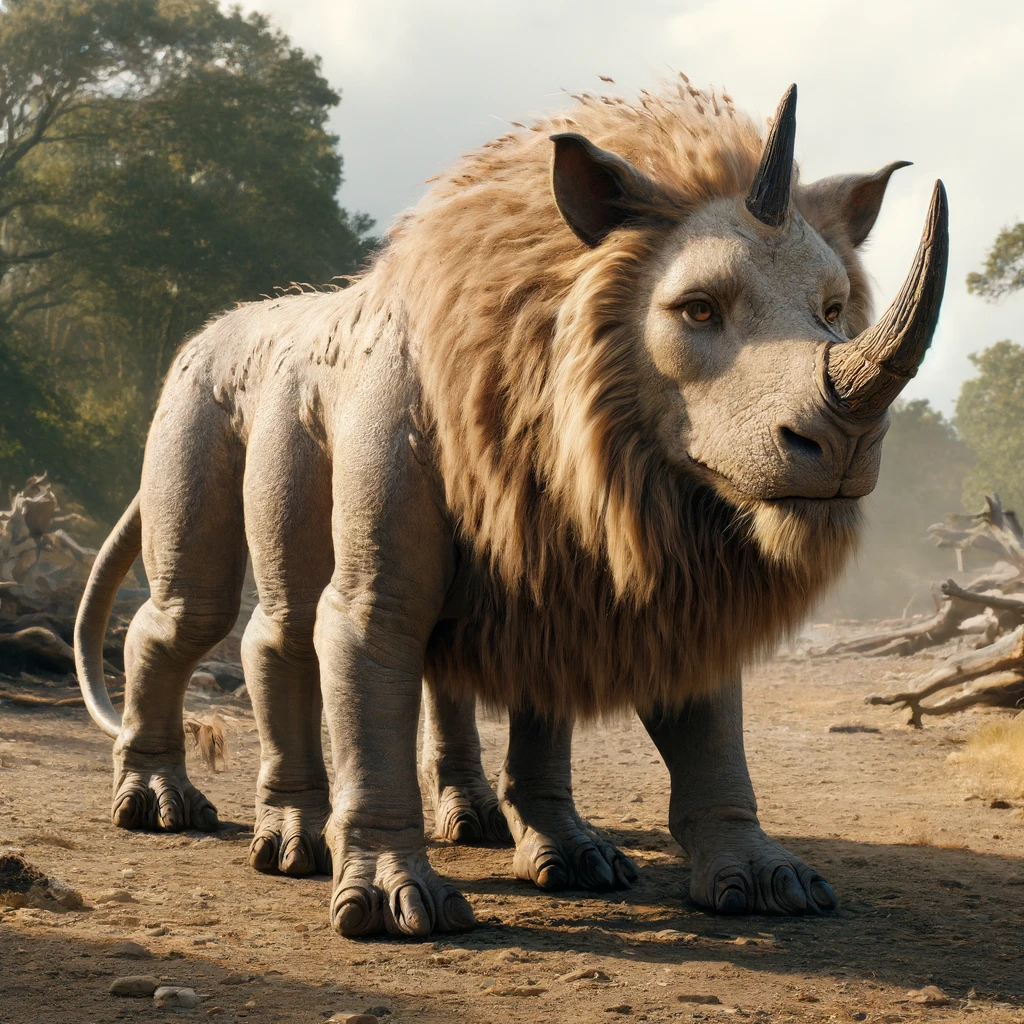Kingdom: Animalia
Phylum: Chordata
Class: Mammalia
Order: Perissodactyla
Family: Rhinocerotidae
Genus: Rhinoceraetus
Species: R. leonicornis
Common Name: Lion-Rhino
Description:
The Lion-Rhino (Rhinoceraetus leonicornis) is a unique and formidable mammalian species that combines characteristics of both rhinoceroses and lions. This hybrid creature boasts a robust body reminiscent of a rhinoceros, coupled with a majestic mane and a facial structure akin to that of a lion. The Lion-Rhino stands out due to its impressive dual horns, one above the nose and a smaller one on the forehead, providing it with formidable defenses against predators and rivals.
Physical Characteristics:
- Size: Adult Lion-Rhinos can reach up to 4 meters in length and stand approximately 2 meters tall at the shoulder.
- Weight: They can weigh between 2,000 to 3,000 kilograms.
- Coloration: Their skin is typically a dusty grey, providing excellent camouflage in their natural habitat. The mane, which ranges from tawny to dark brown, adds a regal appearance to the species.
- Legs: They possess six sturdy legs with broad, padded feet, each featuring three toes that end in thick, blunt nails, providing stability and support.
Habitat:
The Lion-Rhino is indigenous to the Nunavut Sector Overview A Sector, commonly referred to as a Provincial Sector, is a designated area of space within the broader and diverse cosmic region known as the Canadian Expanse. These Sectors function similarly to provinces, contributing to the organization and governance of this vast territory. Structure and Division The Canadian Expanse is divided into thirteen Provincial Sectors, each with its own... More, thriving in the region’s unique blend of tundra and boreal forest ecosystems. These environments provide the varied terrain and resources necessary for their survival.
Overview A Sector, commonly referred to as a Provincial Sector, is a designated area of space within the broader and diverse cosmic region known as the Canadian Expanse. These Sectors function similarly to provinces, contributing to the organization and governance of this vast territory. Structure and Division The Canadian Expanse is divided into thirteen Provincial Sectors, each with its own... More, thriving in the region’s unique blend of tundra and boreal forest ecosystems. These environments provide the varied terrain and resources necessary for their survival.
Behavior:
- Diet: As herbivores, Lion-Rhinos primarily graze on grasses, leaves, and shrubs. Their strong jaws and broad lips allow them to feed on a variety of vegetation.
- Social Structure: Lion-Rhinos are typically solitary but can be seen in small family groups consisting of a female and her offspring. Males are more territorial and often roam alone, except during mating seasons.
- Reproduction: Females give birth to a single calf after a gestation period of around 16 months. Calves remain with their mothers for up to three years before becoming independent.
Conservation Status:
The Lion-Rhino is currently classified as “Vulnerable” due to habitat loss and poaching. Conservation efforts are underway to protect their natural habitats and reduce human-wildlife conflicts.
Cultural Significance:
The Lion-Rhino holds a special place in local folklore and mythology, often depicted as a symbol of strength and nobility. Its distinctive appearance has made it a subject of fascination and reverence among indigenous cultures in the Nunavut Sector Overview A Sector, commonly referred to as a Provincial Sector, is a designated area of space within the broader and diverse cosmic region known as the Canadian Expanse. These Sectors function similarly to provinces, contributing to the organization and governance of this vast territory. Structure and Division The Canadian Expanse is divided into thirteen Provincial Sectors, each with its own... More.
Overview A Sector, commonly referred to as a Provincial Sector, is a designated area of space within the broader and diverse cosmic region known as the Canadian Expanse. These Sectors function similarly to provinces, contributing to the organization and governance of this vast territory. Structure and Division The Canadian Expanse is divided into thirteen Provincial Sectors, each with its own... More.
Research and Observation:
Continued research is essential to understand the Lion-Rhino’s ecological role and behavior. Conservation programs are focused on habitat preservation, anti-poaching measures, and raising public awareness about the species’ plight.
References:
- Smith, J. D., & Carver, L. M. (2024). The Mammalian Hybrids: An Ecological Study of Rhinoceraetus leonicornis. Journal of Exotic Mammals.
- Wildlife Conservation Society. (2024). Conservation Efforts for the Lion-Rhino.
This profile serves as a comprehensive overview of the Lion-Rhino, highlighting its unique characteristics, habitat, and the conservation challenges it faces. Continued efforts are necessary to ensure the survival of this remarkable species.

